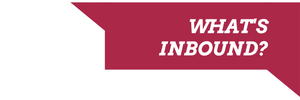Inbound marketing vs outbound marketing
You may have heard the term 'inbound marketing' recently and wondered how it differs from 'normal' marketing. Well, we're here to help de-bunk the differences, if any exist at all.
/Typewriter_keys_letters_words_keyboard.jpg?width=1125&name=Typewriter_keys_letters_words_keyboard.jpg)
Do either have room for traditional marketing techniques?
Both sit in different philosophical camps. Inbound is a near Utopian concept that dreams of a marketing strategy that is so good that customers find you. Normal marketing, or outbound marketing as it's more commonly known, involves communicating to an audience in the expectation that some will be receptive to your message and will enquire.
Both are trying to achieve the same thing - drive enquiries, but they take very different approaches and taking a hybridised approach can muddy the waters, rather than increase effectiveness.
Before we dive deeper let's recap on outbound marketing. What does this typically look like?
For many organisations it's reactionary, focused on supporting a sales function and is often seen as a necessary black hole in the budget. Businesses approach elements of marketing as a box-ticking exercise that may pay off, or may not. There's concern that turning off the tap will have a negative impact but many businesses can't account for which activities yield results. Outbound is often incredibly visible. Print advertising, mail outs, event attendance and flyers are typical examples of outbound efforts. You'll see acronyms like AIDA used when describing effective outbound marketing (Attention, Interest, Desire, Action).

The interconnecting elements of traditional and digital marketing create confusion for marketers.
Inbound looks at 3 key areas of a marketing funnel and measures each stage for improvements. As an inbound marketing agency we apply these principles daily. At the 'Attract' phase research is conducted to see what prospects are looking for at the early stage of seeking a solution to a problem. 'Convert' looks at the communications and materials available to advise a prospect on the correct solution for them. 'Close' ensures the marketing infrastructure is in place to capture that lead, qualify them and pass them on to sales. Websites play a more vital role in inbound and often need to be restructured to deliver the desired outcomes.
As you can see inbound is more pro-active and targeted. Instead of casting a wide net and dragging in leads (many of which are not good fits) inbound looks to refine the approach and bring in contacts that are more qualified.
Outbound marketing often uses metrics like 'reach', 'impressions' and 'visitors' as the main metric for success. The idea here is the more people you reach the more opportunities are created.
Inbound typically looks at 'engagement' and 'conversion' instead. Yes increasing reach can help but without increasing conversion at each point the increased reach is more likely to create more useless leads.
Metrics like brochure downloads are outbound statistics, the conversion rate of visitors to downloads is an inbound stat. Website enquiries are likely to go down when the inbound approach first gains momentum as time-wasters are filtered out, but as the data on a 'good fit' client grows more can be done to target them.
Using inbound and outbound together, on a platform like HubSpot, can greatly increase efficiencies and performance. Learn what an inbound marketing agency does here.
Download your free guide to Smarter SEO
Good SEO can mean the difference between your business being found, or you being lost in the growing mass of online resources. This guide is designed to help you rise above your competition.
Download now

/Typewriter_keys_letters_words_keyboard.jpg)


